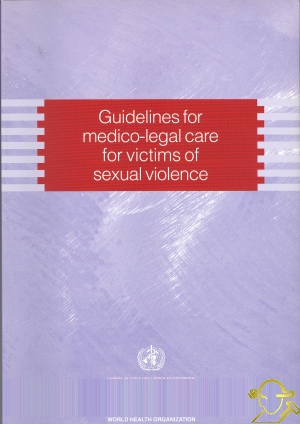Guidelines for medico-legal care for victims of sexual violence
İÇİNDEKİLERContentsAcknowledgements 1. Introduction 1.1 Sexual violence: a global problem 1.2 Why are these guidelines needed? 1.3 Aims of the guidelines 1.4 Using the guidelines 1.5 Reviewing the guidelines 2. Sexual violence: prevalence, dynamics and consequences 2.1 Definition of sexual violence 2.2 Types of sexual violence 2.3 Prevalence 2.4 Dynamics of sexual violence 2.4.1. Rape myths 2.4.2 Risk factors 2.5. Health consequences 2.5.1 Physical consequences 2.5.2 Psychological consequences 3. Service provision for victims of sexual violence 3.1. General considerations 3.1.1. Priorities 3.1.2 The setting 3.1.3 Timing 3.1.4 Service providers 3.1.5 Ethical issues 3.1.6 Local policies and laws 3.1.7 Relationship with investigators 3.1.8 Interaction with other services 3.2 Facilities 3.2.1 The location 3.2.2 Equipment 3.3 Establishing a service for victims of sexual violence 3.3.1. Initial considerations 3.3.2 Evaluation and monitoring 4. Assessment and examination of adult victims of sexual violence 4.1. Overview 4.2 The initial assessment 4.2.1. Assessing the priorities 4.2.2 How health workers should conduct themselves 4.2.3 Obtaining consent GUIDELINES FOR MEDICO-LEGAL CARE FOR VICTIMS OF SEXUAL VIOLENCE 4.3 Taking a history 4.3.1 General medical history 4.3.2 Gynaecological history 4.3.3 The assault itself 4.4 The physical examination 4.4.1 General principles 4.4.2 The "top-to-toe" physical examination 4.4.3 The genito-anal examination 4.5 Recording and classifying injuries 4.5.1 Injury description 4.5.2 Classification of wounds 4.5.3 Genito-anal injuries related to penetration 4.5.4 Injury patterns and their interpretation 4.6 Diagnostic tests, specimen collection and forensic issues 5 Forensic specimens 5.1 The purpose of forensic specimens 5.2 Forensic specimen collection techniques 6 Treatment and follow-up care 6.1 Physical injuries 6.2 Pregnancy prevention and management 6.2.1 Emergency contraception 6.2.2 Pregnancy testing and management 6.3 Sexually transmitted infections 6.3.1 STI testing 6.3.2 Prophylactic treatment for STIs 6.4 HIV/AIDS 6.4.1 HIV testing 6.4.2 Post-exposure prophylaxis 6.5 Hepatitis B 6.6 Patient information 6.7 Follow-up care 6.7.1 Medical review 6.7.2 Counselling and social support 6.7.3 Referrals 7 Child sexual abuse 7.1 Definition of child sexual abuse 7.2 Dynamics of child sexual abuse 7.2.1 Risk factors for victimization 7.2.2 Dynamics of disclosure 7.3 Physical and behavioural indicators of child sexual abuse 7.3.1 Sexualized behaviours 7.3.2 Genito-anal findings 7.4 Health consequences 7.5 Assessment and examination of children 7.5.1 General considerations 7.5.2 Consent and confidentiality issues 7.5.3 Interviewing the child 7.5.4 Taking a history 7.5.5 The physical examination 7.6 Collecting medical and forensic specimens 7.7 Treatment 7.7.1 Children and STIs 7.7.2 HIV and post-exposure prophylaxis 7.7.3 Pregnancy testing and management 7.8 Follow-up care 7.8.1 Diagnostic conclusions 7.8.2 Reporting abuse 7.8.3 Follow-up treatment 7.8.4 Counselling and social support 8 Documentation and reporting 8.1 Documentation 8.1.1 How and what should be documented? 8.1.2 Storage and access to records 8.1.3 Epidemiological surveys 8.2 Photography 8.3 Providing written evidence and court attendance References Bibliography Annex 1. Sample sexual violence examination record Annex 2. Medical issues and sexual violence Annex 3. Health worker education and training    |



